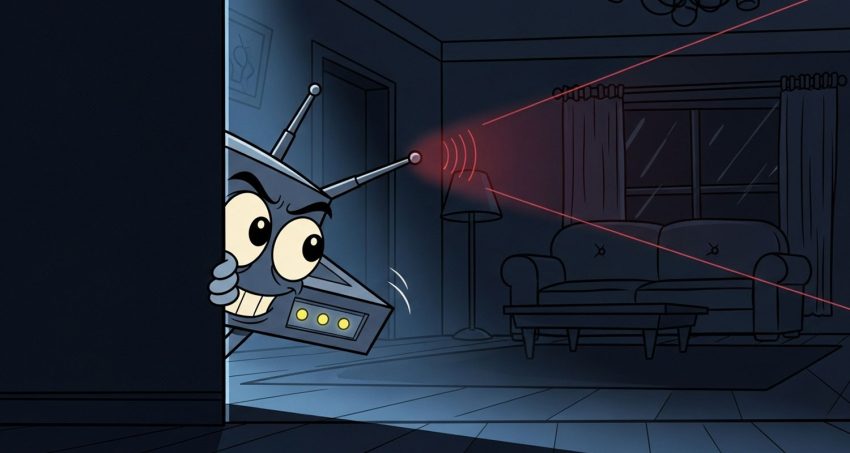 Imagine this: your Wi-Fi router knows when you’ve fallen down the stairs, whether you’re having trouble breathing and exactly how many times you’ve visited the loo today.
Imagine this: your Wi-Fi router knows when you’ve fallen down the stairs, whether you’re having trouble breathing and exactly how many times you’ve visited the loo today.
It can also detect when your teenager is sneaking out at night and monitor your elderly parents’ daily routine from across the country. Most unsettling of all, it can do this through walls, in complete darkness, and without your knowledge.
Welcome to Wi-Fi sensing – a technology that’s about to transform every wireless device in your home into a sophisticated surveillance system.
Twenty-five years ago, Steve Jobs waved an Apple laptop through a hula hoop while streaming a film wirelessly during a presentation, and just like that Wi-Fi was “born”. Now those same invisible signals are about to become invisible eyes, watching our every move.
The technology builds on a simple principle: Wi-Fi signals bounce around rooms like an invisible octopus with tentacles reaching everywhere. When you walk through your living room, you’re disrupting these signals in unique ways. Advanced algorithms analyse these disruptions to create a representation of your movements, turning your home’s Wi-Fi into a motion-detection system.
The same distorted channel state information read from the Wi-Fi router has also been integrated into FaceBook’s OpenSource DensePose software by certain universities to create estimates of human pose in a wireframe-like image.
But this isn’t just about knowing someone’s in the room. Technology developed at MIT in the US monitors breathing patterns by detecting tiny chest movements, recognises specific gestures for smart home control, and even distinguishes between different people based on their gait and body shape.
The business case for digital snooping
The wireless industry is salivating over the commercial possibilities. IEEE 802.11bf – the specification making Wi-Fi sensing ubiquitous – requires no additional hardware where the sensing software is loaded into the router via the OpenSync platform and managed in the cloud. Your existing router, smart TV and even your Wi-Fi-enabled kettle could become sensing nodes in an invisible surveillance network.
Internet service providers will be able simply to push a software update and offer premium “safety and security” services. This could then enable “value-added” services like monitoring elderly relatives for falls, child safety monitoring and home security motion detection. It’s brilliant: take infrastructure customers already paid for, add AI magic in the cloud and charge monthly fees for services costing virtually nothing to deliver.
The privacy nightmare
Wi-Fi 7’s roll-out is laying the groundwork for this sensing revolution. Its party trick is using all frequency bands simultaneously rather than hopping between them – like having multiple conversations at once instead of taking turns. It can even perform “channel puncturing”, identifying interference and working around it. This will give far superior sensing, but the reality is that basic Wi-Fi sensing can already run on WiFi 5.
These improvements create the high-quality, low-latency connections that make real-time sensing applications possible. When your router processes signals from multiple bands simultaneously with minimal delay, it becomes far more capable of detecting subtle environmental changes.
But here’s where things get creepy. This technology works through walls. Your neighbour’s Wi-Fi signals are already penetrating your home, bouncing around your bedroom and returning with information about your activities. With Wi-Fi sensing enabled, they could potentially monitor your movements, sleep patterns, even your breathing.

What’s particularly unsettling is how this democratises surveillance capabilities once exclusive to law enforcement. Previously, seeing through walls required expensive thermal imaging or ground-penetrating radar. Now, any tech-savvy individual with a standard router could potentially monitor their neighbours. For this reason, the commercial solutions available today only offer basic motion detection and not imaging.
At Wapaloza 2025, we demonstrated this live – using a volunteer and a standard Wi-Fi 5 connection in my hotel room, we showed the audience how the technology detected someone “breaking in” as soon as the network registered their movement.
Consider the data this could collect: when you wake up, bathroom duration, exercise habits, guest visits, work schedules. This creates a comprehensive profile of your daily life invaluable to marketers, insurers or anyone willing to pay. The implications for domestic abuse, stalking or voyeurism are chilling.
The road ahead
The IEEE 802.11bf standard will be finalised imminently, with mass market adoption following soon after. Unlike previous Wi-Fi upgrades requiring new hardware, sensing capabilities can be added through software updates to OpenSync enabled routers. This means silent deployment without consumers realising their devices gained surveillance capabilities.
The industry is positioning Wi-Fi sensing as safety and convenience technology – helping elderly people live independently, protecting children, providing family peace of mind. These are compelling use cases many will genuinely value.
Read: Wi-Fi or mobile? Tug-of-war over 6GHz intensifies
But we’re entering uncharted territory regarding digital privacy and consent. When your internet connection monitors breathing, tracks movements and potentially identifies activities, the line between helpful technology and invasive surveillance blurs.
As we stand on the brink of ambient surveillance, one thing is certain: the Wi-Fi router humming in your living room is about to become far more than an internet gateway. The question is: who will be watching?
- Paul Colmer is executive committee member at the Wireless Access Providers’ Association
- Read more articles by Colmer on TechCentral
Don’t miss:
South Africa’s digital divide: the real heroes aren’t who you think

